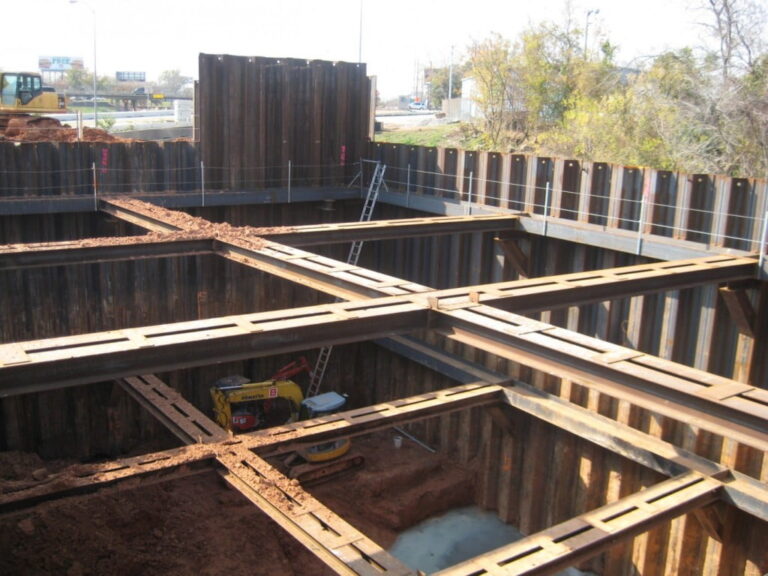In civil engineering, shoring is a fundamental aspect of construction projects, particularly those involving excavation and trenching. Shoring is the process of momentarily supporting a building, structure, or trench with shores when in danger of collapse or during restoration or alterations. Supporting techniques vary widely depending on the project requirements, with options ranging from hydraulic shores to slide rail systems. Each method offers unique benefits tailored to address specific engineering challenges, such as soil stability and load distribution.
This article delves into the importance of shoring design, illustrating how it is crucial in safeguarding workers and infrastructure during construction activities. Emphasizing flexibility and adaptability, these techniques ensure that every project meets safety standards while maintaining structural integrity. This adaptability is particularly essential in complex urban environments or sensitive historical renovation projects, where traditional excavation methods may pose risks.
The Purpose and Importance of Shoring
It is employed to prevent the collapse of earth walls at construction sites, making it essential for ensuring the safety and stability of both the site and its adjacent areas. The primary purpose of this is to stabilize structures and provide protection to workers who might otherwise be at risk due to potential structural failures.
Efficient designs are critical in urban environments where excavations are deep, and space is limited. In these scenarios, the integrity of neighboring buildings and underground utilities must be meticulously preserved. Thus, efficient designs help maintain the structural stability of the construction site and its surroundings.
Types of Shoring Designs
It comes in various forms, each tailored to the specific requirements of construction projects. Here are a few common types:
- Hydraulic Shoring: This method involves using hydraulic pistons that can be pumped outward until they press against the trench walls. It is quick to deploy and is typically used in trench works for utility lines and pipes.
- Beam and Plate Shoring: This type consists of steel beams and plates and is used to hold up large excavations. It is particularly useful in urban constructions where the excavation depth is significant.
- Soil Nailing: This technique stabilizes existing slopes by inserting steel bars into the soil, which are then grouted to create a stable mass. Soil nailing is adequate for both temporary and permanent applications.
- Sheet Piling: This method, used primarily for waterfront structures, involves driving interlocking steel sheets into the ground to form a wall. It is crucial for controlling groundwater flow during construction projects.
Each type of shoring is selected based on factors such as soil setting, excavation depth, and the proximity of existing structures.
Role of Shoring in Protecting Workers
It plays an indispensable role in ensuring worker safety. Without proper support, the walls of an excavation can suddenly collapse, posing grave risks to anyone within or around the site. By supporting the walls or overhead loads, support systems prevent accidents and enable workers to perform their tasks more efficiently and without fear. To ensure the integrity of these systems, many construction companies rely on professional excavation services.
Furthermore, regulatory bodies have established strict guidelines and safety standards that mandate the use of shoring in various construction scenarios. Compliance with these rules not only promotes safety but also underscores the commitment of construction firms to protect their workforce.
Shoring’s Impact on Infrastructure Protection
Beyond worker safety, it is pivotal in protecting the infrastructure during construction projects. For instance, in urban areas, where buildings are closely packed, improper excavation work can lead to subsidence, causing structural damage to neighboring properties. Shoring systems help to distribute the load and prevent such occurrences, thereby preserving the integrity of nearby buildings and infrastructure.
Additionally, during the renovation of historic buildings, shoring is crucial for maintaining the structure’s stability while allowing for necessary modifications or repairs. It is particularly challenging given the delicate nature of such constructions and the need for precision in support.
Advancements in Shoring Technology
Advancements in technology have notably improved the efficacy and safety of shoring practices. Modern engineering software allows for precise calculations and simulations that help design more effective shoring systems. These technologies enable engineers to predict potential problems and adapt the design accordingly, enhancing both safety and efficiency on the construction site.
Furthermore, integrating GPS and real-time monitoring systems in shoring equipment has revolutionized how engineers approach site safety. These tools provide continuous feedback on the conditions and performance of the structures, allowing for immediate adjustments in response to shifting ground conditions or unexpected load changes. This level of oversight significantly reduces the risk of accidents and ensures that projects adhere to stringent regulatory standards, thereby bolstering overall construction site security.
Shoring design is a critical component of contemporary construction that ensures workers’ safety and infrastructure stability. With the variety of techniques available, engineers can choose the most suitable ways based on the specific needs of each project. As construction projects evolve in complexity and scale, advanced shoring techniques become ever more significant, ensuring that both human lives and structural assets are well-protected.


